Our dogs drive us crazy if they haven’t had enough physical and mental exercise. So this article is all about different jobs for our dogs.
The 20 jobs for dogs we’re featuring in this article do exactly that – they put dogs to work and leave them tired out.
What does it mean to give my dog a job?
When you give your dog a job, you put him to work by letting him do something that makes good use of his breed’s characteristics.
You’ve probably seen working dogs in action at some point or another. Those are the dogs who are doing a specific job like:
- Police dogs
- Border patrol dogs
- Military explosive detection dogs
- Protection dogs
- Search and rescue dogs
- Herding dogs
- Service dogs
When they’re at work, these dogs are performing physical tasks along with obeying voice or hand commands.
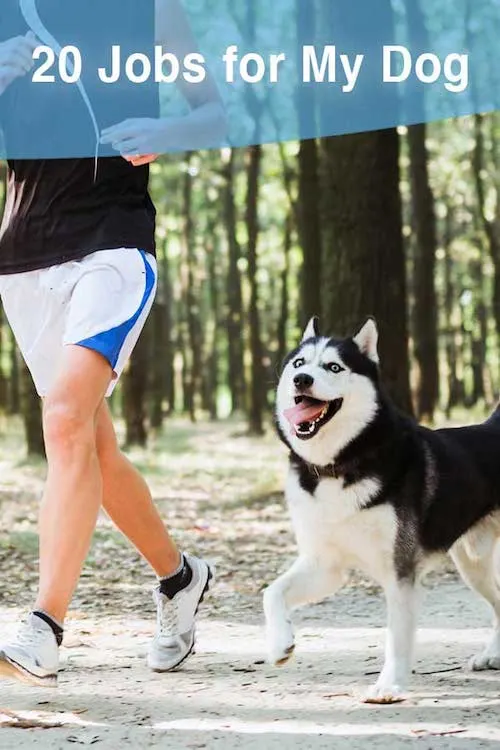
Some of the dog breeds typically used for these jobs are:
- German shepherds
- Labrador and golden retrievers
- Beagles
- Bloodhounds
- Rottweilers
- Boxers
- Doberman pinschers
But this is just a sample. Many breeds can do different jobs, including mixed breeds.
Actually, every dog benefits from having a job, regardless of his breed. Yes, it’s even important for our pet dogs to have some sort of a job.
Why does my pet dog need a job?
Yes! Benefits of giving a pet dog a job include:
- Boosts confidence
- Creates a strong bond between the dog and handler
- Gets rid of pent-up energy
- Fights boredom
- Leaves dogs tired! We sure love it when our dogs curl up or stretch out and snooze after a job well done.
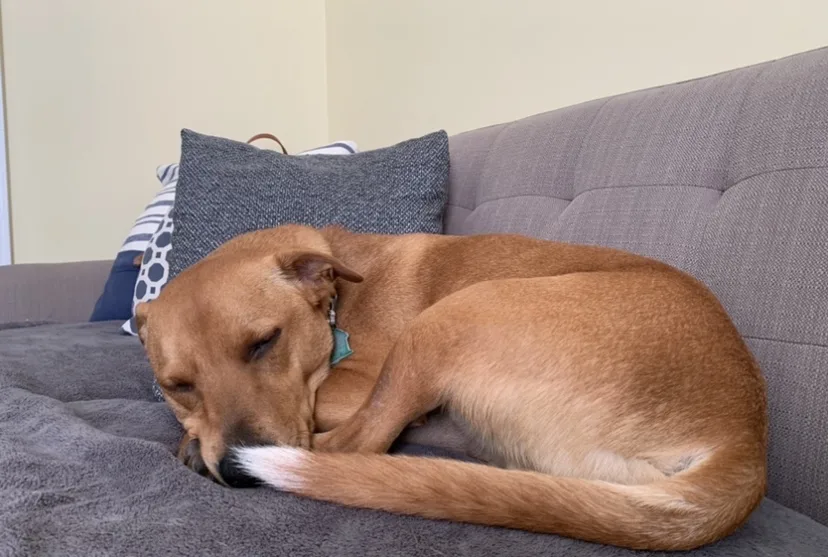
It’s actually easy to tell apart dogs who have a job from those who don’t. Those who do are usually well-behaved, balanced dogs because their handlers funnel their energy into productive work.
Dogs who are “in between jobs” display unwanted behaviors that are commonly referred to as problem behaviors.
You know, like:
So here are some ideas to put that lazy bum sleeping on your couch to work!
What jobs can I give my dog – 20 examples
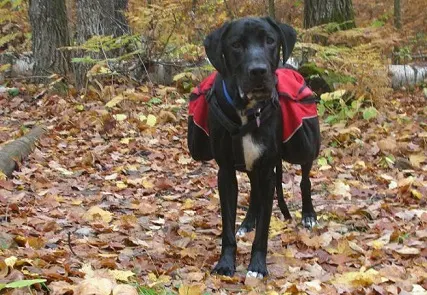
1. Carry a dog backpack.
One of the easiest jobs for my dog is to have him carry his dog backpack during a walk.
This puts the dog into a working mode. Some dogs walk at a “heel” or without pulling when they wear their pack because they’re focused on carrying rather than pulling.
It’s ok to add up to at least 10% of your dog’s weight to the backpack pockets. Just do so gradually. For example, maybe the first couple of walks the pack is actually empty.
We like adding dog toys, first aid supplies, rolls of poop bags, water bottles and cans of beans or whatever really, as long as it adds weight. You can use whatever seems easy enough.
*Enjoying this article? Get realistic dog training tips emailed once a week. Click Here
2. Agility as a job for your dog.
Dog agility is a lot of fun for dogs and their owners! The sport is great because the dog and the handler get exercise.
Any breed (mutts too!) can participate. Many dog-training facilities offer beginning agility classes to the community along with more difficult classes to prepare dogs for competition.
You could also build your own DIY agility course in your backyard. You’ll need the following items:
- Dog “teeter”
- Basic tunnel
- Weave poles
- Jumps
If you’re interested in reading Lindsay’s takeaways from agility class with her Weimaraner Remy, see ThatMutt’s article on agility training.
3. Hunting with your dog.
Most sporting breeds were originally bred to hunt. Even if you don’t actually go hunting, your retriever would love to fetch a stick from water and your springer would love to help flush out birds in a field.
If you actively take your dog hunting, make sure he wears a bright orange vest for increased visibility and safety.
Dogs with high energy and stamina are idea candidates for hunting. Obviously some of these breeds include pointers, weimaraners, vizslas, spaniels and retrievers.
Lindsay started training her dog Remy for hunting recently.
4. Pull a cart or sled.
This is a great job for dogs like huskies and malamutes that were bred to pull sleds and breeds like Rottweilers and Swiss mountain dogs that were bred to pull carts.
Just make sure you introduce your dog to a cart or sled slowly so she is confident and doesn’t get spooked by noisy wheels following her.
Besides a cart or a sled, there are a few accessories you’ll need for carting and sledding, including a specific harness.
See our post on training dogs for the Yukon Quest.
5. Visit a nursing home or other therapy work.
This type of work is great for friendly, well-behaved dogs who enjoy being petted by strangers. With proper training, almost any dog can visit certain schools, nursing homes, hospitals, and libraries. Therapy dogs have to be at least one year old and need to be able to stay calm in distracting environments.
If you’re interested in finding out more specifics about how to become a therapy team with your dog, check out TherapyDogs.com.
Also see That Mutt’s post, What Does a Therapy Dog Do?
6. Dog obedience class.
Both Lindsay’s and Barbara’s mutts crashed when they got home from obedience class because for a full hour they were required to respond to different commands and work amongst other dogs and people.
Obedience classes are a wonderful way of socializing with fellow dog owners and their pups in a controlled training environment.
They’re a good idea for dogs of all breeds, sizes and age groups. A simple Google search will show you which dog training schools in your area currently offer classes.
See our post: What to know about group dog training classes.
7. Games.
We both love to play games with our dogs! Lindsay likes to mess with her dog all the time by hiding from him and calling him or throwing a blanket over his head to see how long it takes him to get it off.
She also plays the “find it” game where she hides objects in a field or on a playground and her pups have to use their noses to find them.
Barbara is also a big fan of playing hide and seek throughout the house. She’ll put her pups in a “sit-stay” or “down-stay” while she hides behind a door or a curtain, under a blanket on the couch or in the bathtub or shower.

She then calls for the pups to come find her and rewards them with lots of praise and/or some high value treats. It’s a super fun game, especially on crappy days when its’s pouring, snowing or blistering hot outside.
Little things like this throughout the day make a dog think, and they make training more fun.
See our post: How to exercise your dog indoors.
8. Mentally stimulating toys.
These are a wonderful option for all size dogs because mentally stimulating toys come in different shapes, sizes and durability levels designed to make a dog think.
We like to fill hollow toys like Kongs with peanut butter and treats so our dogs have to work on how to get the food out.
Occasionally we’ll freeze them for a longer lasting chewing session.
This is another great activity for days when outside time is limited and also for a dog who’s left home alone. Interesting toys will make her less likely to get bored and find her own job.
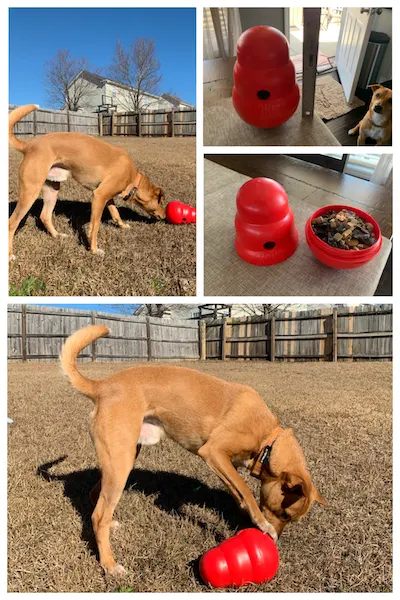
See our post: Most durable dog toys.
*Enjoying this article? Get realistic dog training tips emailed once a week. Click Here
9. Herding.
Sheep herding schools are set up so dogs like Shelties can come and do what they were bred to do. So many of these high-energy breeds like Border Collies end up with behavioral issues because they are so bored with the suburban lifestyle.
Many dogs start trying to herd anything such as other pets, bikes or the kids they live with. Teaching your dog to actually herd sheep is a great way for her to use her instincts.
See our posts on training livestock guardian dogs and teaching my dog to herd.
10. A long walk
It is very mentally challenging for a dog to stay in heel position during a long, controlled walk upwards of 60 minutes.
Keeping her at your side will tire her out much quicker than letting her run ahead and pulling you all over because it will require her to focus.
That being said, it’s also OK to mix it up and let your dog sniff and explore. That can also be a good mental workout. So, mix it up from walk to walk.
We both also like to incorporate certain obedience commands such as “sit”, “down”, and “stay” on our walks. It breaks them up and makes our pups burn even more mental energy.
If your dog is too hyped up to walk at your side, try giving him time to run and play before the walk.
If a walk is not enough for your dog, try running, rollerblading or biking with your dog. You may want to try out a bike leash for dogs so you can have two hands on the bike.
11. Canicross, skijoring & bikejoring.
In canicross, you’re cross country running with your dog ahead of you. Bikejoring is a sport where one or several dogs are pulling you on a mountain bike.
When you’re skijoring, you’re skiing with your dog pulling you. It’s a combination of sled-dog racing (also known as mushing) and cross-country skiing.
Here is a pic of Lindsay doing canicross with her weimaraner, Remy:
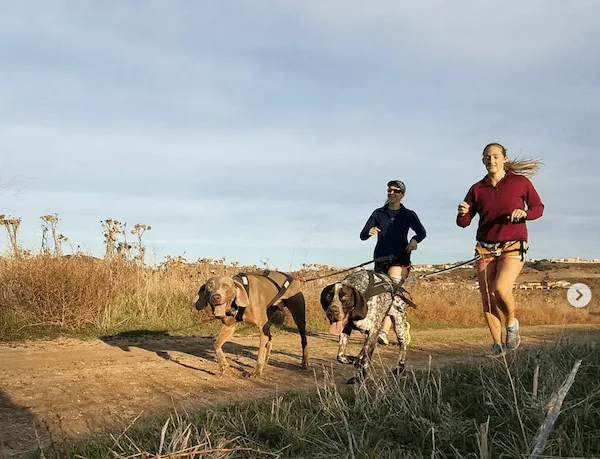
For these sports, you’ll need a harness for your dog that allows comfortable and safe pulling. You’ll also need a waist harness for yourself, a bungee leash and tug-line.
You can also teach your dog specific commands like left, right, woah and go!
12. Search & rescue.
Breeds typically involved in search and rescue work are German shepherds, rottweilers, dobermans, golden retrievers and bloodhounds.
Search and rescue dogs help locate missing, lost or injured people after natural disasters and man made catastrophes, at crime scenes, and whenever someone needs to be rescued or located in general.
The dog needs to be friendly, have stamina and be physically strong to cover different sorts of terrain while searching for someone.
Games like hide and seek are a good starting point for training search and rescue dogs, but dogs will ideally need to begin training while they’re still puppies.
If you’re thinking about enrolling yourself and your pup in search and rescue work, start with a local dog training facility that offers search and rescue classes. In the meantime, you can find out a little more about the topic in That Mutt’s article.
*Enjoying this article? Get realistic dog training tips emailed once a week. Click Here
13. Flyball.
This is a great sport for dogs of all sizes, ranging from Jack Russel terriers to border collies. Flyball is a team sport consisting of two teams with four dogs in each team.
It’s a doggie relay race where the dogs run down an obstacle course with hurdles and retrieve a ball.
This is a sport for well-socialized, fast dogs who can jump and who aren’t dog aggressive. Dogs who practice Flyball need to know basic obedience commands like “sit”, “down”, “stay” and be able to retrieve a ball.
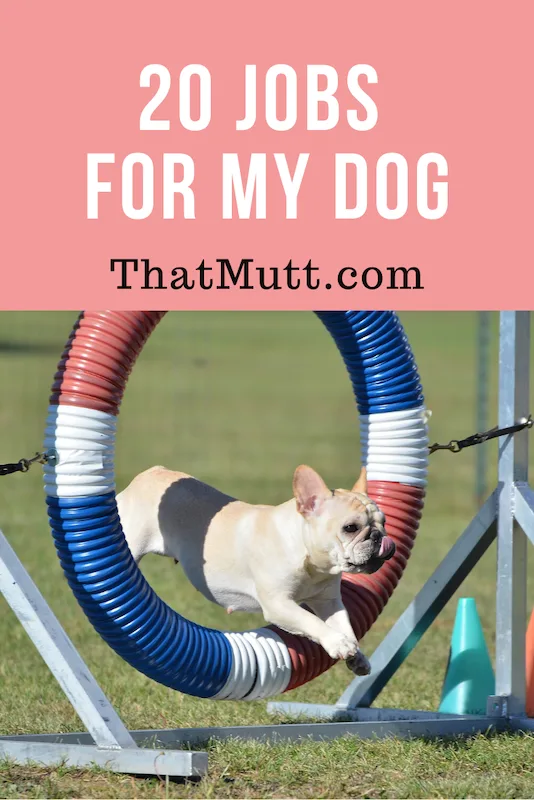
You can find out more about the sport in our intro to flyball article.
14. Nosework.
Nosework is also known as scent work. Compared to other sports like Agility or Flyball, it’s a slow activity that asks dogs to locate different odors using their nose in return for a treat or verbal praise.
The sport is geared towards dogs of all sizes and breeds as long as they like to follow their nose, and which dog doesn’t, right?! Scent work can be particularly beneficial for older dogs and those who are moving at a slower pace due to physical limitations.
Many dog training schools offer Nosework classes, and there’s probably one close to you! You can read more about nosework on our friend’s blog here.
15. Trick training.
Trick training is a great activity for all dogs regardless of age, size and breed.
The saying You can’t teach an old dog new tricks is simply not true, so that excuse doesn’t count. It may take older dogs a little longer to learn a new trick than it does younger dogs, but they’ll welcome a little mental challenge.
Cute tricks to teach could be:
You can either take a dog trick training class at a training facility or teach your dog on your own.
We recommend you use high value treats and a treat bag to hold them around your wait.
16. Visit dog-friendly patios.
Visiting dog-friendly patios with our pups is one of our favorites! It keeps our pups’ socialization skills up to date and it’s just awesome to be able to bring our furries along.
If you’re still working on socializing your dog, try going during the week when the brewery, winery or coffee shop is less busy.
It’s a good idea to go for a longer walk first to make sure your dog doesn’t have pent-up physical energy.
Bring a collapsible water dish and some treats or a longer lasting chew to keep your pup entertained.
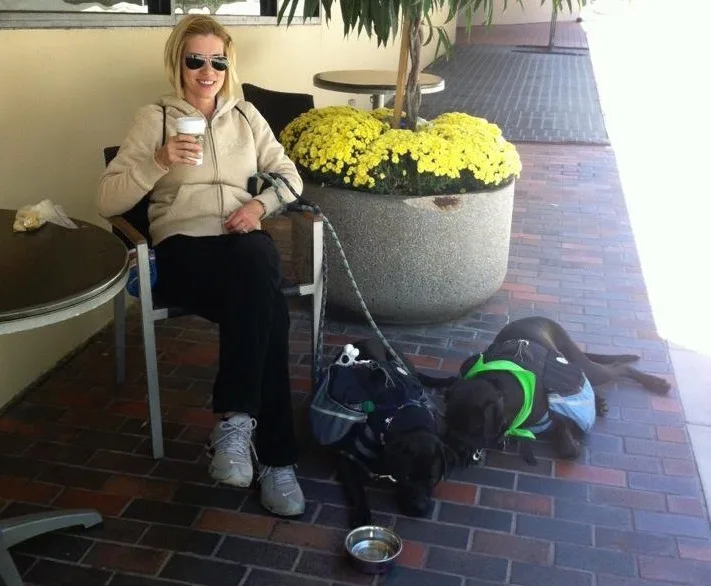
For a comprehensive list of dog-friendly establishments, check out BringFido.
17. Visit pet-friendly stores
Just like visiting dog-friendly patios, pet-friendly stores are another great way of keeping our dogs socialized. Stores that immediately come to mind are pet retailers like PetCo, PetSmart and smaller independently owned pet retail stores.
Many home improvement stores such as Home Depot and Lowe’s also allow well-behaved, leashed dogs.
18. Running is a good job for your dog.
Running with your dog is a great activity for healthy, high-energy dogs who really need to stretch their legs.
Older dogs with joint problems are not always good running candidates (ask your dog’s vet), and dogs with shorter muzzles like boxers, bulldogs and pugs also don’t make the greatest running buddies (usually, anyway).
That’s because of their shortened nasal passages that make it harder for them to breathe.
Lindsay is a runner and even used to own a dog running business, so it doesn’t come as a surprise that she takes her own pups running as well. She shares her thoughts on when it’s safe to start running with a puppy here.
Also see our post on training for a half marathon with your dog.
19. Swimming & dock diving.
Swimming is a wonderful low-impact sport for dogs of all ages as long as they don’t mind getting wet! It’s especially beneficial for dogs with joint issues and arthritis.
The ocean and lakes are one option of where to take your dog swimming, but you’ll want to be aware of your local wildlife such as dangerous water snakes and jelly fish.
It’s a good idea to keep your dog harnessed and attached to a long lead in order to be able to safely reel him back in should he get distracted by something or get carried away by a current.
You might also consider investing in a doggie life vest.
A safer option is a specific dog pool that can be found at many pet resorts. Barbara used to take her Boxer mixes swimming at indoor doggie pools, but unfortunately her current Feist mix Wally wants nothing to do with water.
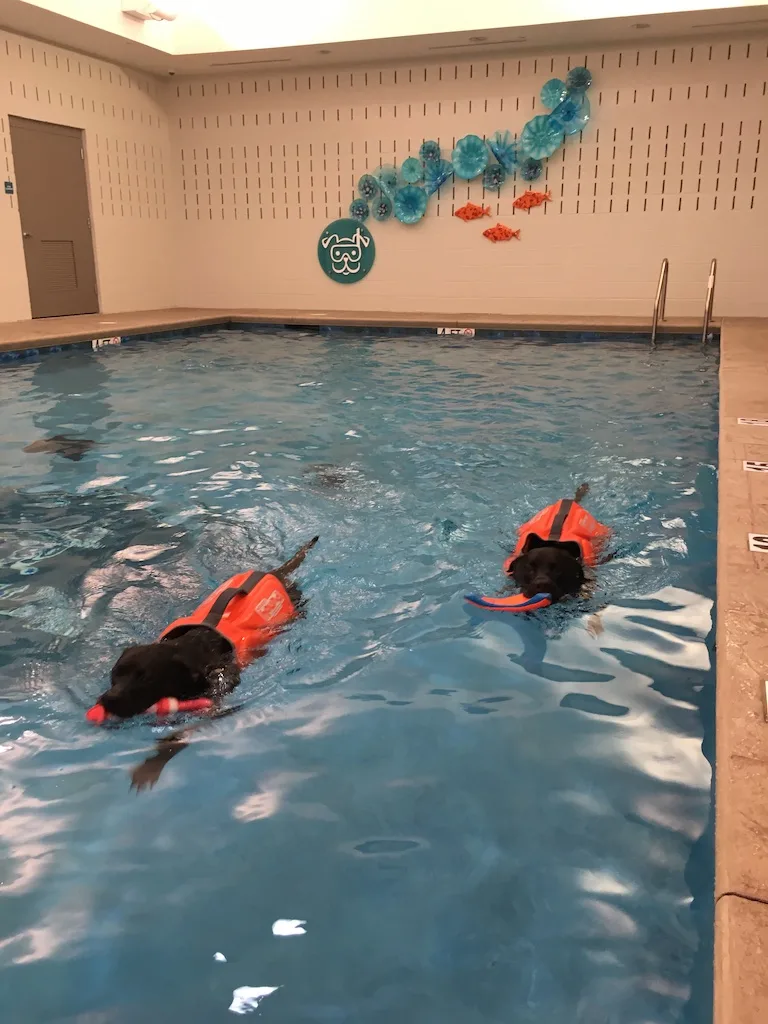
In dock diving, dogs jump after a toy off a dock and into a pool. A judge measures how far each dog jumps, and the one with the furthest distance wins.
This competitive sport is great for high energy, healthy dogs who love the water and who have a strong toy drive.
20. Schutzhund
Schutzhund is an intense activity geared towards tracking, obedience and protection dog training.
It’s a sport for large, high-energy dogs that focuses on protective instincts, desire to work, courage and trainability.
You’ll learn sport-specific commands usually in German, Dutch or Czech for actions like “Stay”, “Fetch”, “Attack”, and “Heel.”
The most common breeds to enroll in Schutzhund training are German Shepherds, Belgian Malinois, Rottweilers and Doberman Pinschers.
Dogs that need a job
As you’ve seen, it’s fairly easy to give our dogs a job, and it certainly doesn’t have to be anything as advanced as Schutzhund or Search and Rescue. All dogs should have some sort of job!
A structured backpack walk, run and trick training are very effective as well.
If your dog is a lovable mutt and you’re not sure what exactly his breed characteristics are, you could do a doggie DNA test. It’ll give you a good idea of his genetic makeup and will list the predominant breeds in his heritage.
This information can make it easier to find the right activity = job for your dog than having to take a wild guess. One of the most well known kits is Embark.
Does your dog have a job?
Let us know in the comments!
*Enjoying this article? Get realistic dog training tips emailed once a week. Click Here
FAVORITE PRODUCTS FOR ACTIVE DOGS:
- Hands-free dog leash. We love the hands-free leash from Mighty Paw!
- Kong Wobbler Toy. Fill with dry food or treats so your pup has to push the toy around to get the food.
- Fresh dog food. My pups eat fresh dog food from The Farmer’s Dog. Get 50% off your first order. Click Here.
Barbara Rivers writes regularly for That Mutt. She is certified in raw dog food nutrition from Dogs Naturally Magazine and the author of three ebooks about balanced raw dog food. She is a blogger at K9s Over Coffee.
Lindsay Stordahl is the founder of That Mutt. She writes about dog training, dog exercise and feeding a healthy raw diet.

Where Can I Work With My Dog
Saturday 22nd of October 2022
[…] Carry a dog backpack. One of the easiest jobs for my dog is to have him carry his dog backpack during a walk. Agility as a job for your dog. Hunting with your dog. Pull a cart or sled. Visit a nursing home or other therapy work. Dog obedience class. Games. Mentally stimulating toys.[1] […]
Top 28 How To Give Dog A Job Lastest Updates 10/2022
Sunday 9th of October 2022
[…] Read More […]
Kim Chappell
Sunday 29th of November 2020
Kenji is an Australian Cattle Dog, which is like a Border Collie on steroids! I don’t have access to livestock, so Kenji has a daily job of walking on his treadmill to keep his mental focus and high physical energy satisfied. Often treadmills are used more for the mental enrichment it gives, than the physical aspect of it. He does just a walk, but with duration, usually a minimum of two hours every day. He automatically gets on the tread, no collar or leash anymore. He also works for all his kibble doing basic obedience drills, tricks, impulse control exercises, Box Feeding, Food toss game, and general grooming/handling procedures .
I have a detailed article on treadmill training for dogs,which I can post here if you are interested. ❤️❤️
Vicki
Thursday 31st of March 2022
@Kim Chappell, would Love to see the article!
Liza S.
Saturday 13th of December 2008
Thanks, the three dog blogger and Lindsay. The Springer finally arrived a couple of days ago and we got to set it up today and go for a first ride with Keeda. She loved it! We'll have to stick to short rides for a while until we build up her endurance. I barely even felt her pulls. One thing I was worried about is that perhaps putting a harness on her, which encourages her to pull, while biking would cause her to pull in regular situations with a buckle collar as well, but so far that hasn't been a problem. Then again we have only had one ride so far.
Lindsay Stordahl
Wednesday 10th of December 2008
Liza, I bike with my dog all the time in the summer. I just hold his leash in my left hand and he runs right at my side so I have never considered buying a Springer or any other kind of bike attachment. I imagine they work very well, though. And they allow the person to have both hands free.